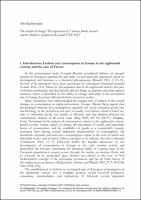Chapter The catalyst of change. The clothing of the Viennese servants and their relation to fashion in the period 1760-1823
| dc.contributor.author | Kafantogias, Aris | |
| dc.date.accessioned | 2022-06-01T12:29:47Z | |
| dc.date.available | 2022-06-01T12:29:47Z | |
| dc.date.issued | 2022 | |
| dc.identifier | ONIX_20220601_9788855185653_797 | |
| dc.identifier.uri | https://library.oapen.org/handle/20.500.12657/56613 | |
| dc.description.abstract | In the eighteenth century, fashion constituted a fundamental criterion for consumption for broader parts of the European (and Viennese) population. This article investigates, through various sources, like probate inventories, fashion magazines and pattern books, the consumption of clothes and accessories of female servants in the period 1760-1823 and associates it with debates on their appearance at the time. It compares their wardrobes to those of a broad part of the Viennese female middle-class population, and examines the relation of their wardrobes to fashion, notably in the period of the emergence of Viennese fashion. Finally, it investigates whether female servants could function as intermediaries of the prevalent fashion between the elites and this middle stratum, and, consequently, as trendsetters for this group. | |
| dc.language | English | |
| dc.relation.ispartofseries | Datini Studies in Economic History | |
| dc.subject.other | Fashion | |
| dc.subject.other | consumption | |
| dc.subject.other | servants | |
| dc.subject.other | Vienna | |
| dc.subject.other | eighteenth century | |
| dc.title | Chapter The catalyst of change. The clothing of the Viennese servants and their relation to fashion in the period 1760-1823 | |
| dc.type | chapter | |
| oapen.identifier.doi | 10.36253/978-88-5518-565-3.15 | |
| oapen.relation.isPublishedBy | bf65d21a-78e5-4ba2-983a-dbfa90962870 | |
| oapen.relation.isbn | 9788855185653 | |
| oapen.series.number | 2 | |
| oapen.pages | 39 | |
| oapen.place.publication | Florence |

